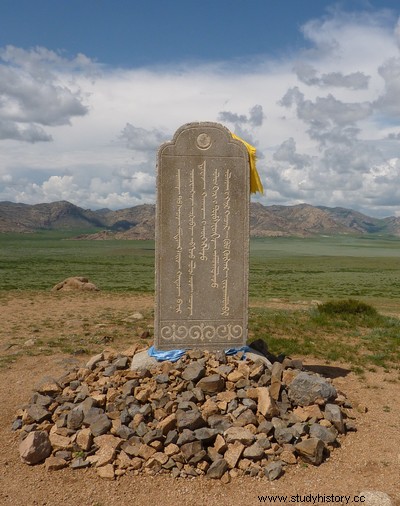Mandukhaï Khatun (Мандухай хатан), also known as Mandukhaï Sechen Khatun, Queen Mandukhaï the Wise (c. 1449 – 1510) was a queen of post-imperial Mongolia, best known for reuniting the Mongols with her husband.
The conquest of power

Daughter of Chorosbai, adviser to the Ongüt Mongols (Turkish-Mongolian tribe), Mandukhaï was born around 1449 in Eastern Mongolia into an aristocratic family. At the age of 18, she was married to Manduulu (English), of the Northern Yuan dynasty, ten years her senior. Since the death of Molon Khan (English) in 1465, the throne remained vacant and the Mongol clans struggled for power until 1475, when Manduulu was crowned and became Manduul Khan. Mandukhai and Manduul have a daughter. The Khan's first wife, Yekhe Khabartu Yungin, had no children and this advantage allowed Mandukhaï to supplant her.
In 1478, Manduul Khan died, possibly poisoned by his adviser Ismel, and left the throne vacant:he had no male heir. Several men, including Ismel and the noble general Unubold, covet the throne and the queen. But Mandukhaï reveals the existence of a young seven-year-old orphan, Batu-Mongke, the last direct descendant of Genghis Khan, whom she adopts. Using his prestigious ancestry, she proclaims him Dayan Khan. The new Khan is very young, and Mandukhai assumes the regency, effectively taking command of the Mongols.
Unity of the Mongols
At war with the Oirats (Western Mongol tribes, also known as Kalmouks), Mandukhaï Khatun led the fight against them until obtaining a resounding victory, which earned him a great reputation. She and Dayan Khan punish the Oïrats by imposing a set of rules on them, relating in particular to armament or marks of deference due to the khans. Their submission effectively unites the Mongol tribes. When Dayan Khan turns nineteen, Mandukhaï marries him and thus reaffirms his power and his legitimacy. She inducts him again into the Eight White Yurts, a mausoleum dedicated to Genghis Khan. The Oïrats then rise again and the queen leads an army against them. Pregnant, she does not abandon her command post and gives birth to twin sons in the middle of the battle. Again, Mandukhaï defeats the Oïrats and maintains the unity of the Mongols.
Beyond the western Mongol tribes, tensions are exacerbated with the Chinese Ming Dynasty. From 1480, the queen and her husband closed trade with China, and carried out a few occasional attacks. In response, China extends the Great Wall to defend itself and conducts incursions into Mongolia.
Mandukhaï Khatun died in 1510. Accounts of his death differ. For most sources, she died of natural causes. Others say that after an attack from China, Mandukhai, returning to the palace, finds Ismel on the throne. A fight would have started between the two, before the queen was shot down by the arrow of an archer in the pay of Ismel. Others, finally, report that she would have been killed by a concubine of her husband. These last two stories have never been proven.
